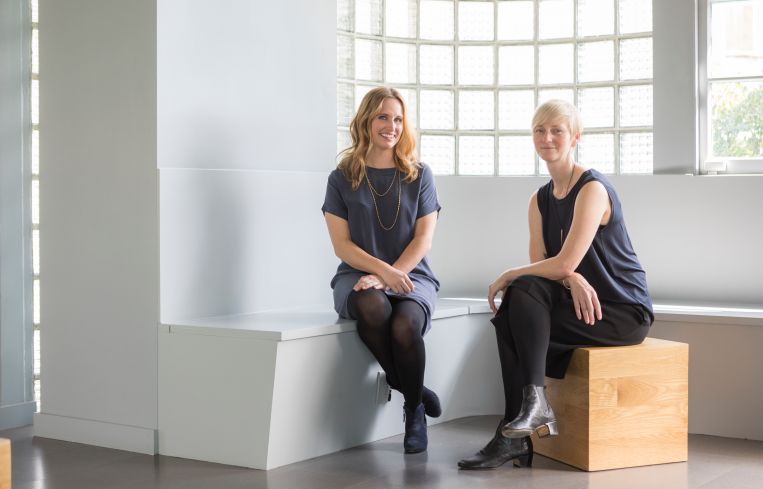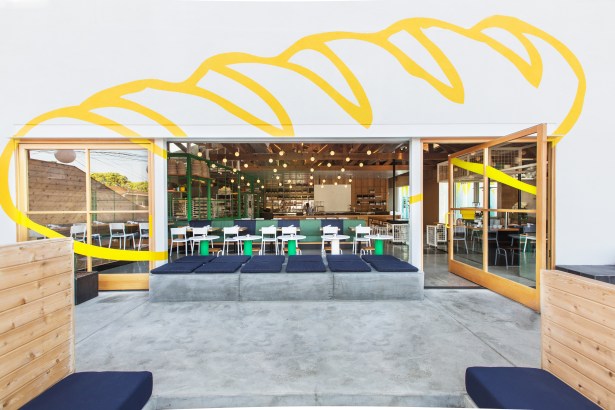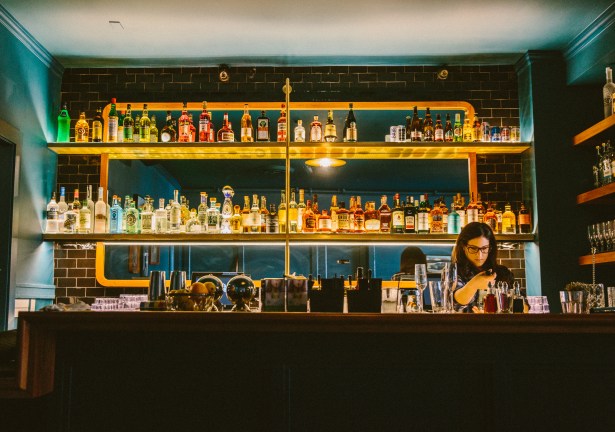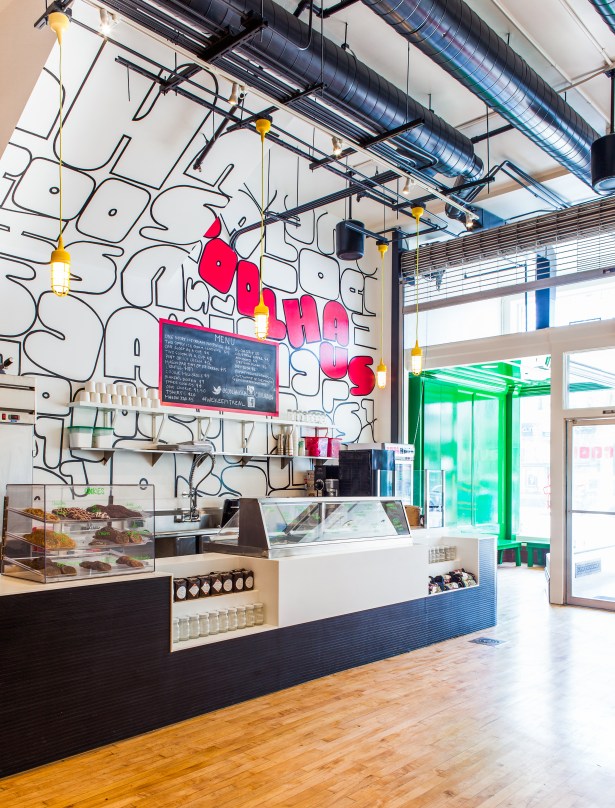For LA Duo, Architecture Is All About Design, Bitches
By Alison Stateman June 25, 2018 8:24 am
reprints
The inspiration for Catherine Johnson and Rebecca Rudolph’s firm came in 2010 in the aftermath of the Great Recession.
The two colleagues at Barbara Bestor Architecture took part in a competition by the American Institute of Architects in Los Angeles meant to buoy the spirits of young architects witnessing a wave of layoffs. Contestants were told to fill in the blank to the following open-ended statement: “Architecture is ____.”
Their answer: Design, Bitches.
This went on to become the eyebrow-raising cheeky name for the firm they co-created.
The duo, who started accepting jobs at their firm in 2012, originally worked out of Rudolph’s Atwater Village home. Now based in an approximately 1,000-square-foot space in Glassell Park, the studio exterior gives no hint at its interior.
Housed in a black low-slung industrial building, with no working doorbell—“It was stolen,” Rudolph explained, pushing open the iron-gated door—the studio is soothingly appointed in muted tones with design books and other inspirational objects organized within. The space seems to reflect a contemporary, unfussy sensibility that informs the duo’s work for commercial and retail clients, including Coolhaus (Ice Cream Sandwiches), Superba Snack Bar and Superba Food + Bread in Venice (which both won American Institute of Architects L.A. restaurant design awards in 2012 and 2014 respectively) and the the Lodge Room/Checker Hall in Highland Park. Johnson and Rudolph are also serving as creative directors for Runway, a Playa Vista-based shopping center being reimagined by DJM Capital Partners.
Both native Californians hold master’s degrees in architecture from SCI-Arc (Rudolph also has a master’s in philosophy from the University of Paris VIII). As their four-member staff quietly worked in the shared open studio, Johnson, 43, and Rudolph, 44, spoke to Commercial Observer with easy rapport about their work and ongoing creative collaboration.

Commercial Observer: You do a lot of work with food and beverage clients and event spaces. Do you seek that out, do these clients come to you, or is it a little of both?
Catherine Johnson: I had an instructor once who said: Be careful with the first project that you take because then it will likely lead you down a path of doing more. It kind of happened that some of our early work had been food clients. But then it also falls into this other category of things that we are interested in, which is social spaces where people are meeting or gathering in slightly different ways than they had before—which is tipping us into more, larger projects. We’re doing a little bit more in terms of what those spaces could be. And it’s a nice billboard for your practice—where people can see what we do. We’ve gotten residential jobs from people who have had lunch at Superba Food + Bread so it’s not like we were so obsessed with food and beverage. For an architectural project, they’re complex, just on a smaller scale. There’s a lot of coordination involved and you have to learn a lot about things quickly. The coordination between the equipment needs, the operation of the kitchen, mechanical, electrical, plumbing, it’s a lot more intense in detail than for retail or even an office. There’s a lot of technical things and how the space really works, how it performs. Oftentimes there are different times of day they have to operate in so the aesthetics have to work with the functional quite seamlessly in order to make the space feel a certain way.
Rebecca Rudolph: There’s also an extra level of code requirements and the health department, which can be stringent and influence the design decisions.
How close is your collaboration with your clients?
Johnson: It does differ by client depending on how much they want to be involved. But we have been lucky in that a lot of our clients like to be involved in the process and are interested in the process. They’re kind of risk-takers, a lot of them, so not so inhibited by other rules or certain style dictations. It allows us to break the rules and play with things and mix things together in interesting and unusual ways. Often, in a city like L.A. where we both have lived for a while, we look to the place. I think it’s standard architectural protocol to talk about context, just in terms of scale and size and walkability and stuff like that but we try to mine a little deeper. What are the things in neighborhoods that have always been there but never revealed themselves architecturally? When we were working in Echo Park, there’s a rich history of artists living in Echo Park and you’d visit people’s houses and they would have these amazing things going on in the inside It’s kind of ramshackle old buildings, but they’re recording music and there’s a lot of creative people doing really interesting things.
Rudolph: We also look at things that are not strictly architectural, like interior design, all, any forms of cultural creation, photography, sculpture, fashion, music and things that might just be natural landscape or things that might be happening in the world that are interesting, like neuroscience and technology that inspire us.
Do you go to things together or separately?
Rudolph: A little of both.
Johnson: In L.A., you’re often on the road or you’re taking a side street and we’re always sending each other pictures, “I saw this…” on a little street that I’ve never been down before. We send each other notes and images a lot.
Do you have favorite artists? Architects? Places?
Rudolph: There’s one I want to say, Irving Gill, he was a California architect, he did a bunch of work in San Diego where I grew up. He took influences from Spanish colonial architecture and modernism that was happening in Europe and he synthesized them together to make very simple and beautiful designs that were based on scale and proportion. He also pioneered some interesting building techniques that tilted concrete walls, so he’s an interesting, earlier California example of someone whose work is still inspiring today.
Johnson: I like more architects than I dislike, in general, but I’m trying to think across the spectrum who I always admire. I love [the Tokyo-based architecture firm] Atelier Bow-Wow’s work. It is small and thoughtful, but also plays with forms that are more normal in residential but then they kind of twist them in unusual ways, which I think is interesting.
Rudolph: There’s a lot of interesting architects coming out of Mexico and Mexico City, women, youngish women architects. There’s Frida Escobedo. I think she’s doing interesting work. She’s doing a variety of different projects and the materiality is beautiful.

When you talk about creating social spaces, it seems part of a trend, related to the rise in technology, where people want to be in these social spaces versus being isolated at home. Do you try to create spaces that are more tranquil for people?
Johnson: We think about that a lot. Starting with food spaces, casually meeting up a potential client in a food establishment has become pretty normal, so there are people working and eating next to somebody who is hanging out with their friend who they haven’t seen in a long time. So, in those spaces specifically, we try and do have different places that people can go for different reasons. Also, let’s say you want to go back to that space three times in a week. You might come with your friend, you might come with your kids, you might come on a date, you’re going to want a different experience.
Rudolph: I think because people are working from home more or working on their own more, they are spending a lot more time in these kind of places—
Johnson: To be around other people—
Rudolph: To be around people, to use the Wi-Fi, to have a drink while you’re sitting there. Maybe some of these establishments were not so concerned with comfort in the past, like they are more elaborate now then maybe 10 years ago.
Johnson: Or more “designy.”
Rudolph: More designy and with more amenities, interior plants and places where you can get—
Johnson: Specialties, like Willy Wonka and chocolate fountains. [Johnson and Rudolph laugh.]
That seems to be a big trend, the ice cream museum and what not. Your use of color is something you are known for. Is there a palette you like to work within?
Johnson: It’s pretty varied. I would say we are pretty color obsessed. We have moments, like, what would an all-white project be like for us? I’d almost like to do one. It would be a test because we both spend a lot of time outdoors and ultimately there is a psychological aspect to the color of light—not just applied material but how things look in different light. That’s something I think about all the time, just walking outside if it’s cloudy or if the sun is setting.
Are there certain places that inspire you in L.A.?
Johnson: I have many because I need to get out of the city. I need to just smell dirt sometimes. There’s lots of great hikes in and around L.A. I like going up into the Angeles National Forest. There are some crazy places that you can dip into that are kind of surprising. There are waterfalls and things that you might not know would be there. I also have a soft spot for all the beaches, whether it’s northern Malibu on the way to Ventura where it gets a little more cliff-like, and the canyons are beautiful, those are some of my favorite.
Rudolph: I like riding my bike a lot. I think Griffith Park and the L.A. River that are close to here where I can ride my bike and up to the mountains, the San Gabriels. I love the beach, but, to be honest, I do not go to the beach in L.A. as much as I would like. My parents still live down in San Diego, so I’ll take [my 10-year-old and 12-year-old daughters] and just go down there, but, yeah, I wish I went to the beach more.
What do you think about L.A. design and development? Are there certain places you think are going the right way? The wrong way?
Rudolph: I think there’s a lot of construction happening now that could be… you know, what’s the word?
Johnson: 90 percent more interesting?
Rudolph: Yeah, a lot of it is driven by economics and people wanting to build it quickly, so a lot of the current multi-family projects going on I wish were better designed, more integrated with the neighborhoods and the landscape.
Johnson: As someone who commutes from Mar Vista on the 10 to the 110 that goes through downtown a lot, that whole Southern end, near the Convention Center, all that tall stuff that is happening. When you think about it, L.A. it is such a creative city filled with creative professionals and people and experimentation. Now when I see all the towers that have been built in the last 10 years, it’s like, it could look like Oz and look super crazy [but does not]. It would fit in L.A. to have a kooky experimental-looking downtown.
Rudolph: There are some projects proposed for the Arts District that I’ve seen, some bigger ones that look more interesting. There’s a Herzog & de Meuron project [a mixed-use undertaking called 6AM].
Johnson: And there’s other Arts District stuff that is trying to be new industrial. Any new fake brick façade in Los Angeles is very fake because you would never build an actual brick building in a seismically active city like Los Angeles. I’d rather they be true to what the city is. Just because there are old brick buildings there, doesn’t necessarily mean you need to match it or try to match that aesthetically.

In addition to L.A., you’ve worked in D.C., where else?
Johnson: Nashville and San Francisco, Seattle.
Rudolph: Miami, Albuquerque.
Johnson: Dallas.
Are there differences working in areas other than L.A.
Rudolph: Yes and no.
Johnson: It depends. I guess there’s always differences, like in Nashville I remember chatting on the phone, “Oh you West Coasters are always in a hurry.”
Rudolph: I think it’s similar in Miami. The pace is slower. It’s funny, honestly because they’re so booming that things can’t happen fast so the permitting process takes a while and the construction process. I mean everyone is busy everywhere, but it’s funny, interesting.
You worked with Google, right?
Rudolph: They have this design conference every year. It’s been, four years now, so we worked on it not this year but the year before. Basically, the Google Design has a team that works on it in-house and they wanted to work with us to bring their graphic vision into a special expression. They also wanted to make the space feel comfortable and encourage creativity and social interaction and these kinds of things that are important to our work. We worked with them on custom furniture and layout and how they incorporate the graphics and use of the space and colors and material.
Johnson: And we created these spatial objects. They were playing with this idea of primitive shapes and we three-dimensionalized some of them and moved them throughout the space. So, there might be a large cone overhead in some space that you could stop under and chat with somebody. We took it off the walls and into the room. It was very experiential.
Subscribe to CO’s Los Angeles Weekly Newsletter for more stories like this at commercialobserver.com/subscribe



